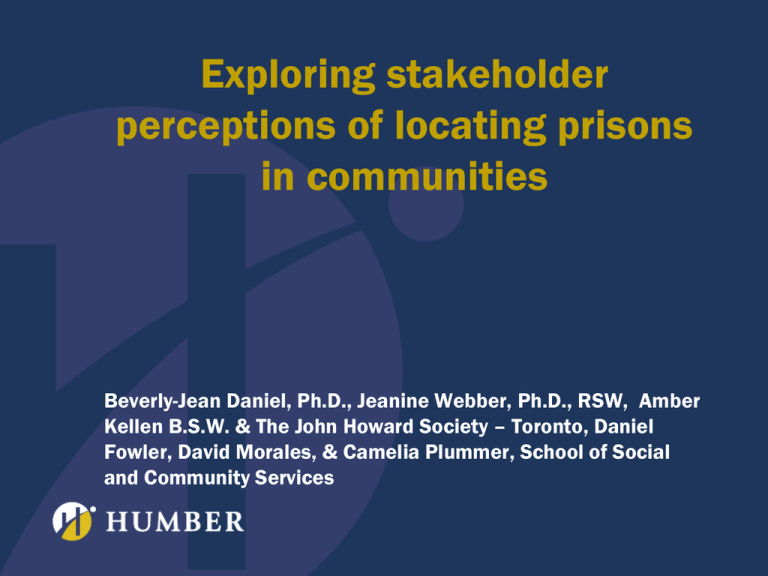See the PowerPoint Presentation
advertisement

Exploring stakeholder perceptions of locating prisons in communities Beverly-Jean Daniel, Ph.D., Jeanine Webber, Ph.D., RSW, Amber Kellen B.S.W. & The John Howard Society – Toronto, Daniel Fowler, David Morales, & Camelia Plummer, School of Social and Community Services Agenda Project overview Methods Sample Results Limitations Future directions Student RA experience Project Overview This joint research project between Humber College and the John Howard Society – Toronto, focused primarily on: • Conducting a preventative needs assessment to determine the impact of locating the Toronto South Detention Centre within the local South Etobicoke community • Identifying the preventative options that can be introduced to address stakeholder concerns • Determining actual safety concerns versus the subjective concerns of stakeholders to identify strategies for reducing the concerns amongst the stakeholders. Methods This research project utilized a mixed method approach, including: • • • • • Questionnaires Focus groups Community meetings Quantitative data analysis using Statistical Product and Service Solutions (SPSS) Qualitative data analysis – Grounded Theory Approach Sample Sample : 203 Respondents • • • • • • Humber Students (n=80) Residents (n=53) Humber Staff (n=28) Business Owners (n=23) School Officials (n=10) Social Agencies (n=9) Results The respondents indicated that they anticipate that there would be a reduction in the value of properties in the neighbourhood. Results The respondents also indicated that their perception of the neighbourhood would be significantly worse once the detention centre is opened. Results The respondents, particularly women, believed that the neighbourhood would become less safe when the detention centre opens. Results The following quotes highlight the respondents request for a heightened police and security presence to help reduce identified risk and safety concerns: • Respondent: “More police patrol, neighborhood watch, more cameras (CCTV)” • Respondent: “Better security; lighting at night, cameras & increased security presence” Results The following quotes highlight the respondents concern about the well-being of the releasees and support reintegration programs: • Respondent: “Communities to provide employment opportunities, educational opportunities, recreation opportunities, transitional help for inmates to the community” • Respondent: “Support groups, mental health support, drugs and alcohol supports, life skills support” Limitations With our research project there are two key limitations to the study: 1) Sample may not be fully representative of each of the stakeholder groups given small sample size for each group 2) Detention centre not yet operational therefore no comparison data available to identify differences between anticipated and real differences in neighbourhood safety, reputation, property rates etc. Future Directions There are several future indications for this research project: 1) Expand the study to include a larger and more representative population sample 2) Develop a longitudinal study that will facilitate the examination of the theorized versus the actual impact of the prison 3) Conduct an assessment on the efficacy of the development of a reintegration hub (as proposed by the John Howard Society – Toronto) and the resulting impact on the real differences in the area – real estate values; conception of the neighbourhood, etc.











